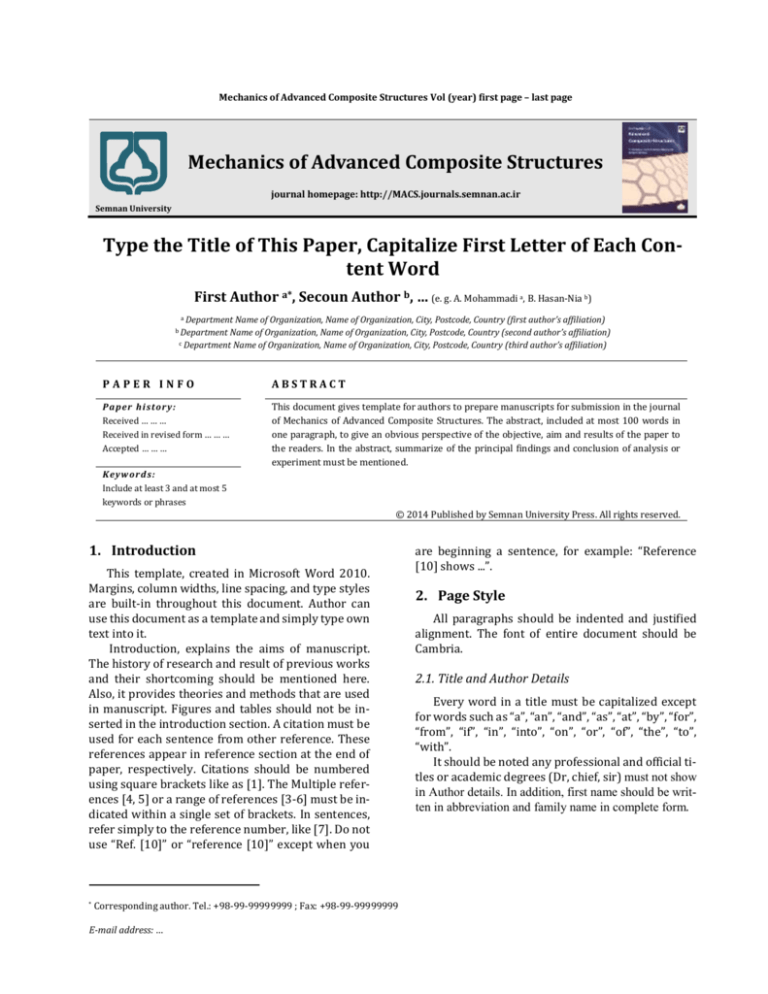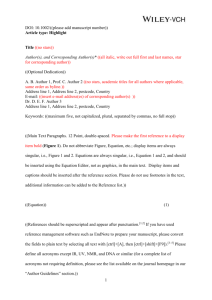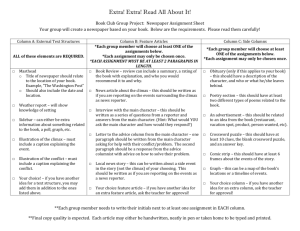
Mechanics of Advanced Composite Structures Vol (year) first page – last page
Mechanics of Advanced Composite Structures
journal homepage: http://MACS.journals.semnan.ac.ir
Semnan University
Type the Title of This Paper, Capitalize First Letter of Each Content Word
First Author a*, Secoun Author b, … (e. g. A. Mohammadi a, B. Hasan-Nia b)
a Department
Name of Organization, Name of Organization, City, Postcode, Country (first author’s affiliation)
Name of Organization, Name of Organization, City, Postcode, Country (second author’s affiliation)
c Department Name of Organization, Name of Organization, City, Postcode, Country (third author’s affiliation)
b Department
PAPER INFO
ABSTRACT
P a pe r h i st ory :
Received … … …
Received in revised form … … …
Accepted … … …
This document gives template for authors to prepare manuscripts for submission in the journal
of Mechanics of Advanced Composite Structures. The abstract, included at most 100 words in
one paragraph, to give an obvious perspective of the objective, aim and results of the paper to
the readers. In the abstract, summarize of the principal findings and conclusion of analysis or
experiment must be mentioned.
K ey w ord s:
Include at least 3 and at most 5
keywords or phrases
© 2014 Published by Semnan University Press. All rights reserved.
1. Introduction
This template, created in Microsoft Word 2010.
Margins, column widths, line spacing, and type styles
are built-in throughout this document. Author can
use this document as a template and simply type own
text into it.
Introduction, explains the aims of manuscript.
The history of research and result of previous works
and their shortcoming should be mentioned here.
Also, it provides theories and methods that are used
in manuscript. Figures and tables should not be inserted in the introduction section. A citation must be
used for each sentence from other reference. These
references appear in reference section at the end of
paper, respectively. Citations should be numbered
using square brackets like as [1]. The Multiple references [4, 5] or a range of references [3-6] must be indicated within a single set of brackets. In sentences,
refer simply to the reference number, like [7]. Do not
use “Ref. [10]” or “reference [10]” except when you
*
Corresponding author. Tel.: +98-99-99999999 ; Fax: +98-99-99999999
E-mail address: …
are beginning a sentence, for example: “Reference
[10] shows ...”.
2. Page Style
All paragraphs should be indented and justified
alignment. The font of entire document should be
Cambria.
2.1. Title and Author Details
Every word in a title must be capitalized except
for words such as “a”, “an”, “and”, “as”, “at”, “by”, “for”,
“from”, “if”, “in”, “into”, “on”, “or”, “of”, “the”, “to”,
“with”.
It should be noted any professional and official titles or academic degrees (Dr, chief, sir) must not show
in Author details. In addition, first name should be written in abbreviation and family name in complete form.
2
Authors / Mechanics of Advanced Composite Structures Vol (year) first page-last page
2.2. Section Heading
Don’t use more than three levels of headings and
those shouldn’t be indent. For third level of heading use
10 pt fonts.
2.3. Footnotes
Footnotes should be avoided if possible. Necessary footnotes should be denoted in the text by consecutive superscript letters. The footnotes should be
typed single spaced, and in smaller type size (8 pt), at
the foot of the page in which they are mentioned, and
separated from the main text by a short line extending at the foot of the column.
if figure or graphs are duplicated from other reference, a citation should be appearing at the end of caption.
3.1. Tables
Only horizontal lines should be used within a table, to distinguish the column headings from the
body of the table, and immediately above and below
the table. Tables must be embedded into the text.
Table 1. An example of a table
Column A
And an entry
And another entry
And another entry
3. Figures and Tables
All figures and tables should be numbered with
Arabic numerals and must be mentioned in the manuscript. They must be placed as close as possible to
the first reference to them in the paper. In figures,
number and caption should be typed below and in tables those should be typed above. Figures and tables
must be aligned in the centre of column and sized appropriately as width as one column. Although, large
figures and tables that takes up more than 1 column
width should be placed at the top or bottom of a page.
For referring to figure or table don’t use bracket or
parenthesis, for example Fig 1. shows . . .
3.1. Figures
All photographs, schemas, graphs and diagrams
are to be referred to as figures. Low-quality scans are
not acceptable. Figures must be embedded into the
text and not supplied separately. Every figure has a
caption that includes the figure number and a brief
description. This caption must be enough perceptible
with out mention to the text.
Column A
1
3
5
Column B
2
4
6
Details shouldn’t be appearing in caption of the tables. You can put them in footnotes.
All tables, figures, and equations must be set in
two-column format, expect for large tables and figures or long equations that may span across both columns if necessary. Any table, figure, or equation that
takes up more than one column width must be positioned either at the top or at the bottom of the page
(e. g. Table 2 on the next page).
4. Equations
Equations should be numbered consecutively
throughout the paper. Equations and formulae
should be typed by Microsoft Equation (insert-> symbols-> Equation) or MathType and numbered consecutively with Arabic numerals throughout the paper in parentheses on the right hand side of the page
(if referred to explicitly in the text),
𝜎 = 𝐸𝜀
(2)
5. Conclusion
Conclusion may review the main points of the author work. Also, it could include application of proposed method and suggestion for feature research.
Nomenclature
All variable using this manuscript, listed in nomenclature.
X
t&
Me
Figure 1. an example of figure
Sim
Fr
variables should appear in first column
with the definition in second column
One and two-letter abbreviations should
appear in italics
three-letter abbreviations should not appear in italics
Dimensionless number and parameter
don’t appear in italics
Authors / Mechanics of Advanced Composite Structures Vol (year) first page-last page
3
Table 2. Geometrical characteristics of the specimens
Specimens code
Composite tube diameter (mm)
Copper tube diameter (mm)
Specimens type
m (gr)
L (mm)
C-01
C.R-02
C-03
C-04
C.F-05
10
10
12
5
12
-
A
B
A
A
C
1.78
4.77
1.98
0.76
4.91
40
40
40
40
40
C.F-06
C.F-07
CP-08
CP-09
C.C-10
10
5
12
19
16
19
C
C
D
D
G
3.55
1.02
17.09
10.60
26.25
40
40
40
40
40
C.C-11
C.C-12
C.C-13
C.C-14
C.C-15
10
5
12
10
5
19
19
16
16
16
G
G
G
G
G
25.85
25.30
17.86
16.73
17.21
40
40
40
40
40
Acknowledgements
In General, the last paragraph of each paper is the
place to acknowledge people and sponsors for dedicating and financial support. Company names and specific
places should be cited only here. It should be noted that
the heading of the Acknowledgment and the References must not be numbered.
Appendix
Appendixes appear after acknowledgments.
References
Authors are responsible for the authenticity and completeness of all references.
[1] Chern CC, Chen YL, Kung LC. A heuristic Relief
Transportation Planning Algorithm for Emergency Supply Chain Management. Int J of Computer Mathematics 2010; 87(7): 1638–64.
[2] Chai G, Fang C, Gao X, Zhao Q. A Cost-Based
Study on Highway Traffic Emergency Rescue
Sites Location Using Heuristic Genetic Algorithm. J of Computational Information Systems
2011; 7(2): 507–14.
[3] Han CF, Zhang C. Genetic Algorithm for Solving
Problems in Emergency Management. In: Conference on Natural Computation; 2009. p. 259–
64.
[4] Bratton D, Kennedy J .Defining a Standard for
Particles Warm Optimization. In: IEEE Swarm
Intelligence Symposium; 2007. p. 120–7.
[5] Pinedo M. Scheduling theory, algorithms, and
systems. 2nd ed. Prentice Hall; 2002.
[6] Bazaraa M, Sherall H, Shetty C. Nonlinear programming, theory and algorithms. New York:
Wiley; 1993.
[7] Norwood DS. An analysis of Interlaminar
Stresses in Unsymmetrically Laminated Plates.
Ph.D. Thesis, Virginia Polytechnic Institute and
State University, 1990.
[8] Mittelstedt C, Becker W. (2003). Three Dimensional Closed-Form Analysis of the Stress Field
at Rectangular Corners of Layered Plates, Archive of Applied Mechanics, 73: 63–74









